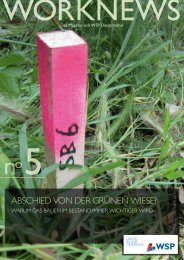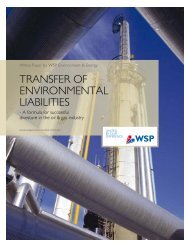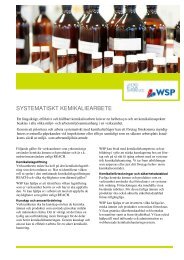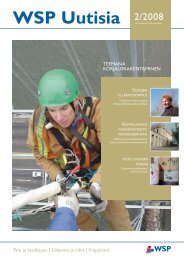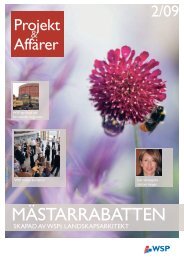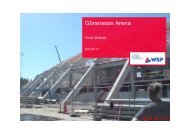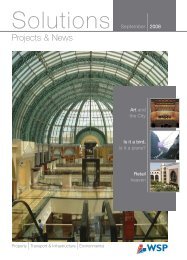06 HEALTHCARE FOCUS - WSP Group
06 HEALTHCARE FOCUS - WSP Group
06 HEALTHCARE FOCUS - WSP Group
You also want an ePaper? Increase the reach of your titles
YUMPU automatically turns print PDFs into web optimized ePapers that Google loves.
March2012<br />
<strong>06</strong><br />
Healthcare<br />
focus<br />
10<br />
14<br />
15<br />
on site at Bond<br />
Street Station<br />
testing sweden’s<br />
metal<br />
the secret life<br />
of bridges<br />
UNITED<br />
BY OUR<br />
DIFFERENCE
the<br />
Firsts<br />
PAGE<br />
At <strong>WSP</strong>, we’RE united<br />
BY our passION for<br />
INNOVATION and our<br />
PIONEERING sPIRIT. here<br />
ARE just a few of our<br />
LATEst breakTHROUGHs.<br />
Vodafone<br />
Innovation Centre<br />
The first six-star<br />
building in AfrICa<br />
The Vodafone Site Solutions Innovation<br />
Centre in Midrand, South Africa, has just<br />
been accredited by the Green Building<br />
Council of South Africa to become the<br />
first building in Africa to receive the<br />
highest, six-star rating under its Green Star<br />
sustainability rating system. <strong>WSP</strong> provided<br />
structural, mechanical, plumbing and<br />
drainage, and sustainability engineering<br />
services to the centre, which includes an<br />
array of innovative technologies and will<br />
be used to develop alternative solutions to<br />
help reduce carbon emissions across the<br />
Vodafone group’s worldwide operations.<br />
simon.berry@wspgroup.co.za<br />
the 200th Green Star<br />
in australia<br />
<strong>WSP</strong>’s specialist environmental design<br />
consultancy in Australia has just secured<br />
its 200th Green Star under the Australian<br />
Green Building Council’s accreditation<br />
system. The team provided environmental<br />
sustainable design on the redevelopment<br />
of 500 Bourke Street in Melbourne,<br />
Victoria, a 1970s office tower covering<br />
47,000m². The building has now secured<br />
a five-star rating, making it the largest<br />
refurbished building to achieve a<br />
five or six-star rating. The project was<br />
also exceptional in that the base build<br />
and fit-out refurbishments were carried<br />
out at the same time, and because tenant<br />
National Australia Bank remained in<br />
occupation throughout the works.<br />
david.jarratt@wspgroup.com.au<br />
AfrICa’s<br />
greenest hotel<br />
Arrivals at Cape Town International<br />
airport will soon be able to check into<br />
the greenest hotel on the continent, the<br />
143-room Hotel Verde. Because the<br />
South African Green Star scheme does<br />
not yet include a rating tool for hotels, the<br />
project is instead registered under the US<br />
LEED system, with the aim of achieving a<br />
gold rating. <strong>WSP</strong> will provide ICT design<br />
services. The project will incorporate<br />
many sustainable features such as a<br />
geothermal heating, ventilation and air<br />
conditioning system, greywater recycling,<br />
photovoltaic panels, movement-sensorcontrolled<br />
lighting and energy-efficient<br />
appliances.<br />
mark.behrmann@wspgroup.co.za<br />
Europe’s most<br />
modern airport<br />
<strong>WSP</strong> Germany is delivering Berlin<br />
Brandenburg International airport, a<br />
completely new facility that will replace<br />
all three of Berlin’s existing airports when<br />
it opens in June 2012. As if managing<br />
every aspect of the 1,470ha project was<br />
not challenging enough, the 77-strong<br />
<strong>WSP</strong> team also had to carry out a major<br />
redesign to incorporate new screening<br />
equipment when new EU security rules<br />
were announced midway through the<br />
construction phase. This means that BBI<br />
will be the first airport to use the new<br />
technology – a test case for other airports<br />
around the world.<br />
christine.roenisch@wspcbp-berlin.de<br />
THE INFOTOWER AT<br />
BERLIN BRANDENBERG<br />
INTERNATIONAL<br />
AIRPORT<br />
500 Bourke Street,<br />
Melbourne<br />
The UK’s first<br />
“coMMunityfacing<br />
prISon”<br />
<strong>WSP</strong> has been appointed as part of<br />
a Skanska-led team to deliver a new<br />
prison in Peterhead, Scotland, which will<br />
accommodate 500 inmates across three<br />
cell blocks and a community rehabilitation<br />
unit. Designed to hold all classes of<br />
offender, Grampian Prison will be the<br />
UK’s first custom-built “community-facing<br />
prison”. <strong>WSP</strong> will provide a full range of<br />
design services including environmental,<br />
civil and structural, infrastructure, building<br />
services and acoustics.<br />
alistair.mclean@wspgroup.com<br />
02 solutions
solutions March 2012<br />
CONTENTs<br />
04 NEWs<br />
<strong>06</strong> <strong>HEALTHCARE</strong> focus<br />
10 ON SITE AT BOND Street Station<br />
14 ssAB Steelworks, sWEDEN<br />
15 THE sECRET life of bridges<br />
16 PosTCARD from… Doha<br />
Front cover<br />
Great Ormond Street Hospital<br />
Photo: Nicola Evans, <strong>WSP</strong> <strong>Group</strong><br />
Editor<br />
Bridget Kennerley<br />
<strong>WSP</strong> <strong>Group</strong> Communications<br />
bridget.kennerley@wspgroup.com<br />
Designed and produced by<br />
Supreme Creative<br />
www.supremecreative.co.uk<br />
Written and edited by<br />
Wordmule<br />
www.wordmule.co.uk<br />
This issue of Solutions coincides with the<br />
announcement of <strong>WSP</strong>’s results for 2011, and<br />
once again our performance proved resilient in<br />
the face of varied and often challenging markets.<br />
Our private sector activities showed some improvement, though constraints<br />
remain on confidence and funding across the general landscape. With the<br />
exception of the UK, the public sectors in the regions in which we work generally<br />
improved as the year progressed.<br />
In this month’s magazine we highlight two markets in which we are increasing<br />
our engagement worldwide – healthcare and rail. Our focus on healthcare<br />
reflects our growing global reputation – leading to our recent success in winning<br />
Odense Hospital, Denmark’s largest ever hospital project, among others –<br />
and demonstrates our pioneering work in the UK, US, Sweden, Germany and<br />
Australia. We also feature one of our flagship rail projects, Bond Street Crossail<br />
station in London, where we are lead consultant. Further significant appointments<br />
from both Crossrail and Network Rail have followed in the UK, including our role<br />
as lead design consultant on the redevelopment of London Bridge station and,<br />
more recently, a place on not one but two frameworks for the new high-speed<br />
London to Birmingham rail link.<br />
Client care is a key pillar of our business strategy, and a theme that runs through<br />
every story in the magazine. Whether we are designing a complex steelworks<br />
refurbishment in Sweden, running structural diagnostic tests on bridges in the<br />
US, masterplanning sustainable cities in Scandinavia or engineering high-rise office<br />
and hotel developments in Asia, our priority is to understand and respond to our<br />
clients’ business requirements with the very best solutions.<br />
I hope you enjoy this insight into just a few of our many, varied projects around<br />
the world, and I look forward to telling you more about our work in other<br />
markets and sectors as the year progresses.<br />
Chris Cole<br />
CEO, <strong>WSP</strong> <strong>Group</strong> plc<br />
solutions 03
news for<br />
ThIS issue… creating future cities<br />
in sweden and finland, gearing<br />
up for high-speed rail in the uk,<br />
and deSIgning A DANCIng BRIdge<br />
china<br />
H+, Helsingborg<br />
<strong>WSP</strong> to desIGN susTAINABLE<br />
CITIEs across Scandinavia<br />
Our teams in Sweden and Finland have won a series of prestigious<br />
commissions to create new sustainable districts in Scandinavian cities.<br />
Their expertise will help the cities to address their future energy<br />
needs, reduce waste and adopt principles of wider sustainability.<br />
In Finland, <strong>WSP</strong> won a competition to<br />
develop a masterplan for a sustainable<br />
community and local food cluster in the<br />
Sibbesborg area of Sipoo, just 30 minutes<br />
by metro from Helsinki city centre. This will<br />
eventually be home to more than 60,000<br />
residents. <strong>WSP</strong>’s vision for the district<br />
is as a cluster of carbon-neutral urban<br />
villages, promoting nature, healthy living<br />
and agriculture. “Sustainability for Sipoo will<br />
not just mean a small carbon footprint but<br />
on board<br />
FOR two UK<br />
HIGH-sPEED rail<br />
FRAMEWORks<br />
also maintaining and advancing the natural<br />
environment, socioeconomic and cultural<br />
strengths, and values of the community.<br />
Our understanding of this is one of the<br />
reasons we won,” said Katriina Rosengren,<br />
<strong>WSP</strong>’s project manager for the project.<br />
Meanwhile, in Sweden, <strong>WSP</strong> beat 10 other<br />
consultants to secure one of the country’s<br />
most exciting city renewal projects, in<br />
the city of Helsingborg. H+ will be a new<br />
district in the city centre’s southern part,<br />
<strong>WSP</strong> has secured a place on two of the four<br />
six-year frameworks to provide engineering<br />
and environmental services for the delivery<br />
of High Speed 2, a new rail link from London<br />
to Birmingham. In total, 13 consultants<br />
were appointed across the four different<br />
frameworks, but <strong>WSP</strong> was one of a select few<br />
to be listed in two sections. The team scored<br />
highly on both technical and commercial<br />
aspects of the bid, reflecting <strong>WSP</strong>’s growing<br />
and <strong>WSP</strong> is working with the energy<br />
company Öresundskraft to develop a<br />
sustainable energy system, covering energy,<br />
waste and water. It will be based on<br />
renewable sources and will be both energypositive<br />
and cost-neutral on an annual basis.<br />
<strong>WSP</strong> Sweden is also developing a carbonpositive<br />
energy and waste roadmap for the<br />
new Royal Seaport district in Stockholm,<br />
under the Clinton Climate Initiative,<br />
established by the former US president to<br />
find solutions to climate change. These new<br />
assignments build on <strong>WSP</strong> Sweden’s earlier<br />
experiences such as the Brunnshög project<br />
in Lund and earlier phases of the Stockholm<br />
Royal Seaport project.<br />
katriina.rosengren@wspgroup.fi<br />
agneta.persson@wspgroup.se<br />
expertise and reputation in the UK rail<br />
sector, developed over projects including the<br />
redevelopment of London Bridge station,<br />
the new Bond Street Crossrail station, the<br />
recently completed Paddington Station Span 4<br />
refurbishment, and Edinburgh’s Waverley<br />
station. To find out more about <strong>WSP</strong>’s lead<br />
design role on Bond Street, turn to page 8.<br />
dave.darnell@wspgroup.com<br />
04 solutions
PROJECT WINS<br />
DANCING BRIDGE<br />
Wuxi, CHINA<br />
Paddington Station, London<br />
Awards<br />
PADDINGTON<br />
AND EMIRATEs<br />
TEAMS SCOOP<br />
TOP PRIZES<br />
<strong>WSP</strong> has won the Institution of<br />
Civil Engineers’ Historic Bridges<br />
and Infrastructure Award for<br />
the design of the refurbishment<br />
of the Grade I-listed Paddington<br />
station in London, completed in<br />
2011. <strong>WSP</strong> was commissioned<br />
by Network Rail in 2007 to<br />
undertake a feasibility study<br />
to strengthen and refurbish<br />
part of the roof, originally<br />
completed in 1854.<br />
The team, based mainly in<br />
the Basingstoke office, worked<br />
closely with the client and<br />
English Heritage, continuing<br />
throughout the outline and<br />
detailed design stages, and as<br />
lead consultant for contractor<br />
Morgan Sindall during the<br />
two-year construction.<br />
peter.newman@wspgroup.com<br />
<strong>WSP</strong> has been named<br />
Consultant of the Year for 2011<br />
at the annual awards of the<br />
United Arab Emirates’ National<br />
Transportation Authority, held<br />
in Abu Dhabi in January. The<br />
NTA is the federal agency<br />
that covers links between<br />
the Emirates themselves and<br />
neighbouring countries, with<br />
which <strong>WSP</strong> has a strategic<br />
partnership spanning several<br />
projects.<br />
gurminder.sagoo@wspgroup.ae<br />
CHINA<br />
Professionals across <strong>WSP</strong> Asia’s<br />
Shanghai, Shenzhen and Hong<br />
Kong offices have been working<br />
together to deliver a commercial<br />
project by Suning, one of the<br />
largest electrical appliance retailers<br />
in China. The Suning Yi Gou B2C<br />
project is located in the Xuan Wu<br />
district of Nanjing City, and has<br />
a total floor area of 216,000m².<br />
<strong>WSP</strong> will be providing building<br />
services, sustainability and LEED<br />
consultancy.<br />
sidney.chan@wspgroup.com.hk<br />
Sweden<br />
<strong>WSP</strong> has been commissioned<br />
by the municipality of Umeå,<br />
IKEA and IKANO Retail<br />
Centres to produce preliminary<br />
designs for a key part of a new<br />
retail park to the south of the<br />
city. The contract includes<br />
carrying out geotechnical<br />
investigations and producing<br />
designs for roundabouts, cycle<br />
tracks and footpaths, water and<br />
wastewater facilities, parks and<br />
car parks.<br />
tomas.widerstedt@wspgroup.se<br />
SRI LANKA<br />
<strong>WSP</strong> Hong Kong has been<br />
appointed as building services<br />
and LEED consultant on a new<br />
Shangri-La Hotel in Colombo,<br />
the latest in a number of projects<br />
it has delivered for the luxury<br />
chain. The hotel will be located<br />
along Galle Road, south of<br />
the central business district,<br />
and includes hotel rooms and<br />
serviced apartments covering<br />
101,686m².<br />
jackson.kwong@wspgroup.com.hk<br />
QATAR<br />
<strong>WSP</strong> Middle East, in joint<br />
venture with Khatib & Alami,<br />
has been awarded a major<br />
infrastructure contract by the<br />
Qatari Public Works Authority,<br />
ASHGHAL. The $90m contract<br />
is to provide engineering<br />
consultancy services for all local<br />
roads and drainage across the<br />
north of the country for a<br />
five-year period.<br />
To read more about <strong>WSP</strong>’s<br />
growing business in Qatar,<br />
turn to page 16.<br />
andrew.seymour@wspgroup.com<br />
<strong>WSP</strong>’s bridge experts in Finland<br />
and PES-Architects have won<br />
a competition to design a new<br />
pedestrian bridge in Wuxi,<br />
China. The steel and concrete<br />
cable-stayed bridge will span a<br />
small lake close to a new bullet<br />
train station in the central park<br />
of the Huishan New City area.<br />
It is suspended from inclined<br />
pylons that resemble two dancers<br />
and has a gentle S-bend which,<br />
according to Chinese tradition,<br />
ensures a traveller will face no<br />
danger as it makes evil spirits lose<br />
their way. The bridge is expected<br />
to open later in 2012.<br />
sami.niemela@wspgroup.fi<br />
US<br />
<strong>WSP</strong> Cantor Seinuk has been<br />
commissioned to design a new<br />
40-storey Marriot Courtyard<br />
and Residence Inn in New York,<br />
in downtown Manhattan at 213<br />
Pearl Street. The architect for the<br />
175,000ft 2 building is Nobutaka<br />
Ashihara, and the client is Lam<br />
Golden Pearl Plaza Hotel.<br />
tbyrne@wspcs.com<br />
Lam Golden Pearl Plaza Hotel LLC / Nobutaka Ashihara<br />
solutions 05
healthcare focus<br />
A look inside <strong>WSP</strong>’s medical files reveals<br />
a wide array of world-class healthcare facilities.<br />
The next four pages feature some of our<br />
recent success stories in Europe, the US<br />
and Australia, while overleaf, one of our<br />
design partners in New York shares his<br />
thoughts on good hospital design.<br />
case<br />
hisTORIEs<br />
In a company with so many large and innovative projects<br />
around the world, there is bound to be a bit of intra-firm<br />
rivalry about whose are the most challenging to pull off. But<br />
Paul Stanley, director of property and development in <strong>WSP</strong><br />
UK’s healthcare team, thinks he has a few trump cards.<br />
“My colleagues might say a tall building is complicated, but<br />
there is no more complicated building than a hospital,” he says.<br />
“There are critical care wards, operating theatres, and all the<br />
issues around the spread of infection. The power supply has<br />
to be resilient, as does the water. We don’t just have M&E to<br />
deal with, but medical gas supplied to every bed. From a fireengineering<br />
point of view, evacuating a hospital is not like an<br />
office – you’ve got people in beds, people on machines. That’s<br />
what makes a hospital a bit different. At the end of the day, if<br />
the services that go into the building don’t work, people die.”<br />
A laboratory is considered a difficult project in its own right –<br />
in healthcare, it will be one small but crucial aspect. Before you<br />
even reach the construction stage, there will be a mountain of<br />
legal and financial paperwork, depending on which variant of<br />
government finance or PFI is currently in vogue. A hospital’s<br />
transport strategy must accommodate not only patients,<br />
visitors and ambulances, but possibly helicopters landing on<br />
the roof. And finally, Stanley adds, “nine out of 10 hospitals<br />
are built on existing sites, where patients and staff are moving<br />
backwards and forwards all day long”.<br />
Stanley and his team are well practised in overcoming these<br />
difficulties. Over the last 10 years, <strong>WSP</strong> UK has completed<br />
many healthcare projects, from building a brand-new hospital<br />
to extending or refurbishing a single ward. Its reputation for<br />
delivering large hospital projects was sealed with the success<br />
of the £300m Forth Valley Acute Hospital, completed in 2011.<br />
<strong>WSP</strong> staff have just celebrated the opening of the £350m<br />
North Staffordshire University Hospital, and are playing a key<br />
role on the ongoing refurbishment of Great Ormond Street<br />
Hospital in London, not due for completion until 2025. “We<br />
can provide all of the engineering services that are required on<br />
a hospital,” says Stanley. “Not just structural or M&E, but fire,<br />
acoustics, vertical transport, urban planning, traffic, transport.<br />
Our biggest selling point is that we’ve got all of the engineering<br />
skills you need under one roof and an excellent track record.”<br />
Now <strong>WSP</strong> is delivering one of the UK’s largest-ever healthcare<br />
projects – New South Glasgow Hospitals, worth £840m.<br />
Contained in a single building, it has a floor area of 172,000m 2 ,<br />
equivalent to 24 football pitches. A jumbo jet would fit<br />
comfortably inside the atrium. “This dwarfs anything that has<br />
been built before,” says <strong>WSP</strong>’s project director Pete Dunbar,<br />
based in the Glasgow office. “It will be the biggest building in<br />
Scotland by a long way. The nearest is the Edinburgh Royal<br />
Infirmary, and that’s only 120,000m².”<br />
The campus includes a 14-floor adult hospital, with 1,109<br />
beds mostly in single, en-suite rooms, and a 256-bed children’s<br />
hospital. <strong>WSP</strong> is responsible for the main building – being<br />
constructed alongside the existing Southern General Hospital<br />
on the south bank of the Clyde – and the 2,400kW capacity<br />
energy centre that will supply it. Together, they are worth<br />
£650m. “It’s not just a new hospital in south Glasgow, it’s a reevaluation<br />
and review of how healthcare will be provided across<br />
the west coast of Scotland,” says Dunbar. “When it’s complete,<br />
this will be the largest healthcare campus in Europe, providing<br />
maternity, paediatric and acute services on a single site.”<br />
The greatest challenge has been coordinating the vast amount<br />
of information that goes into a building of this size, to ensure it<br />
remains on programme. <strong>WSP</strong> is working with Brookfield, which<br />
pre-qualified in early 2009 and was appointed preferred bidder<br />
in January 2010. A year of design work followed, including a<br />
consultation with clinical staff which brought significant changes,<br />
before the first piles were installed in March 2011. “We started<br />
on site very quickly, but the integrated design was lagging due<br />
to the changes that arose during the clinical consultation,”<br />
this will be the largest<br />
<strong>HEALTHCARE</strong> campus in<br />
EUROPE, providing maternity,<br />
PAEDIATRIC and acute sERVICEs<br />
ON a sINGLE sITE<br />
says Dunbar. “That meant we had to work with Brookfield<br />
to build in more flexibility while those elements of the design<br />
developed.” The structural frame is now well under way, with<br />
three of the main cores at full height, and will be complete by<br />
August 2013.<br />
The project has so far involved staff from seven different<br />
<strong>WSP</strong> offices: Glasgow, Edinburgh, Newcastle, Stockton, Leeds,<br />
Dublin, London and Delhi. “No business outside London has a<br />
team big enough to deal with a project of this size in one office.<br />
This has been a major team effort.”<br />
paul.stanley@wspgroup.com<br />
peter.dunbar@wspgroup.com<br />
<strong>06</strong> solutions
Great Ormond Street Hospital<br />
Morgan Stanley Clinical Building<br />
Photo: Nicola Evans, <strong>WSP</strong> <strong>Group</strong><br />
the paSSIV treatment<br />
HELMUT G WALTHER HosPITAL, Bavaria, GERMANY<br />
<strong>WSP</strong> Germany is delivering one of the country’s first “green”<br />
hospitals, a replacement for the Helmut G Walther Hospital<br />
in Bavaria Lichtenfels. Designed by Munich architect Schuster<br />
Pechtold Schmidt, it consists of two square buildings connected<br />
by a central lobby and a treatment and examination area.<br />
Construction is due to begin later this year, completing in 2016.<br />
Project manager Wolfgang Grossmann believes this is a very<br />
special project: “We have a unique opportunity to create a new<br />
model in clinical buildings, achieving high standards in ecology,<br />
cost efficiency and quality right from the planning phase.”<br />
A committee of architects, landscape architects, civil engineers,<br />
building physicists, ecologists and medical experts was<br />
convened to discuss every element of the building’s design<br />
and delivery, alongside the building owners and the planning<br />
authorities. The result was a 100-page action plan, at the<br />
cutting edge of research and technology. “We’ve taken a<br />
holistic approach to the entire process,” says Grossmann.<br />
“Sustainability starts with the management of the construction<br />
site, and continues during the operational phase of the hospital.<br />
For example, we involved a hospital hygienist who advised us<br />
on the most environmentally friendly disinfectants and how<br />
to minimise the amount of disposable material. This has often<br />
required completely new solutions.”<br />
Aiming for the highest, “gold” rating under the German<br />
Sustainable Building Council’s system, the hospital will use far<br />
fewer resources than conventional buildings. “The goal was to<br />
meet the PassivHaus standard,” says Grossmann. “So we were<br />
aiming for as close as possible to energy self-sufficiency. Due<br />
to the high energy requirements of medical devices, that can’t<br />
be fully implemented, but during times of surplus the hospital<br />
can export the energy it<br />
produces back to the grid.”<br />
The building has high levels<br />
of insulation and triple-glazed<br />
windows, of course, but the<br />
walls also feature advanced “phase<br />
change materials” that store heat<br />
energy and release it slowly to maintain a<br />
comfortable temperature in treatment areas.<br />
The hospital will generate its own energy from a range of<br />
sources, including geothermal energy for heating and cooling<br />
and a biomass boiler to produce steam for sterilisers, ventilation<br />
systems and the kitchen. Photovoltaics will play a prominent<br />
role, with panels on the roofs and in the facades, while the<br />
buildings are oriented to receive maximum sunlight.<br />
The facade also makes the best possible use of natural light.<br />
Integrated, movable shading will shield glare while directing<br />
sunlight to the rear of patients’ rooms. Elsewhere, the hospital<br />
will use energy-efficient LED and OLED lights, with occupancy<br />
sensors to turn them off when rooms are unused.<br />
It is these “smart” elements of the building that present the<br />
greatest challenge, says Grossman. “A decentralised energy<br />
supply requires complex measurement and control systems<br />
to carry out targeted peak load management – shutting down<br />
energy-intensive facilities automatically, for example – and to<br />
ensure the intelligent use of waste heat. Because <strong>WSP</strong> has many<br />
decades of experience, we are perfectly suited to coordinating<br />
the various disciplines and areas of responsibility.”<br />
wolfgang.grossmann@wspgroup.de<br />
Image courtesy of mw2 / Schuster Pechtold Schmidt Architekten<br />
solutions 07
healthcare focus<br />
BIM’s the prescription<br />
Sahlgrenska HosPITAL,<br />
GOTHENBURG, sWEDEN<br />
Sahlgrenska Hospital’s new Centre of Image and<br />
Intervention will use the very latest diagnostic technologies<br />
to detect diseases such as cancer and heart disease at<br />
an early stage, providing patients with better care and<br />
reducing the need for major surgery. Due to open in 2015,<br />
the SEK1.3bn building will include operating theatres with<br />
imaging technologies such as x-ray, ultrasound and magnetic<br />
resonance, a cyclotron with hot lab for treating cancers, and<br />
a central sterilisation supply department.<br />
Such complex project calls for the latest construction imaging<br />
technology too. <strong>WSP</strong> is lead consultant for structures,<br />
electrical, geotechnics, surveying and acoustics, providing a<br />
multidisciplinary team with not only a great deal of experience<br />
of designing healthcare facilities, but of using Building<br />
Information Modelling (BIM) to deliver these projects.<br />
“One of the main challenges on this project is a huge amount<br />
of equipment that must be fitted into a very confined space,”<br />
explains Henrik Carlsson, department manager at <strong>WSP</strong><br />
Construction Design in Gothenburg. “The accuracy of the<br />
data is therefore crucial, and the ability to visualise the project<br />
provides an<br />
environment for<br />
testing before construction<br />
– essential to avoid expensive mistakes.”<br />
BIM has been used throughout the design<br />
as a common platform between the architect, <strong>WSP</strong>’s<br />
structural and electrical engineers, and the building services<br />
engineers too. The model incorporates a number of different<br />
software packages, such as TeklaStructures and Solibiri, used to<br />
detect clashes between different elements of the building. The<br />
whole design is carried out in three dimensions and imported<br />
into a common model using open-source IFC code.<br />
Using BIM has not only enabled the design partners to solve<br />
problems early in the design process, saving both time and<br />
money, it is also been invaluable in many workshops between<br />
the client and the design team, says Carlsson: “The model<br />
helps everyone to work within the engineering constraints to<br />
provide the best possible solution to the medical requirements<br />
of the project.”<br />
henrik.c.carlsson@wspgroup.se<br />
A healthy dose of solar energy<br />
ECHUCA REGIONAL HosPITAL, Victoria, AusTRALIA<br />
<strong>WSP</strong> is breaking new ground in hospital design at the Echuca<br />
Regional Hospital in Victoria, Australia, where it has designed<br />
the country’s largest array of evacuated tube solar collectors.<br />
The hospital has been in operation since 1882, and could no<br />
longer run some of its older, most inefficient air-conditioning<br />
equipment on very hot days. “Our primary objective was to<br />
reduce the overall power consumption,” explains Marthinus<br />
Noyce, associate director at <strong>WSP</strong> in Melbourne. “The target<br />
was a necessity, it wasn’t only to reduce their emissions.”<br />
The solar hot water collectors provide hot water at a<br />
temperature of 95°C to an absorption chiller, which allows the<br />
hospital to reduce the use of an existing air-cooled electric<br />
chiller, meeting the building’s demands without expensive<br />
upgrades to its energy supply. The project was funded partly<br />
by Sustainability Victoria, which supports<br />
innovative pilot projects. With a solar<br />
field covering 300m² and a peak<br />
design output of 220kW, the roofmounted<br />
panels were intended<br />
to reduce the building’s<br />
electricity consumption by<br />
1,373MWh per year. Now<br />
operational for 14 months,<br />
initial indications show it has<br />
exceeded the target, and<br />
that it will cut greenhouse<br />
gas emissions by around<br />
1,400 tonnes per year.<br />
The Melbourne office has designed several cooling plants<br />
using absorption chillers connected to waste heat sources,<br />
but this was their first solar chilling project. It was also one of<br />
the first projects they had delivered using BIM technology for<br />
every aspect, which made for a steep learning curve. The solar<br />
field and mechanical plant were modelled using Autodesk<br />
Revit software, enabling the team to prepare presentationgrade<br />
graphics and videos. “Preparing technical information in<br />
understandable manner to present the various stakeholders<br />
was one of our biggest challenges,” says Noyce. “We found BIM<br />
was an excellent tool for providing a realistic virtual view that<br />
non-technical people could understand.”<br />
The team found themselves specifying equipment that was<br />
not readily available in Echuca, and originally their favoured<br />
technology was from the US and had not been tested in<br />
Australia before. “In the end, we opted for existing technology<br />
which the funder was comfortable with,” says Noyce. “We<br />
produced a design that the client was able to implement with<br />
confidence, and which has still yielded the paybacks we needed.<br />
This project demonstrates <strong>WSP</strong>’s willingness to cooperate with<br />
different agencies to achieve a desirable outcome.”<br />
Indeed, the relationship the team has built with the hospital<br />
is continuing. <strong>WSP</strong> is now designing a new emergency<br />
department, pharmacy, inpatient accommodation and an<br />
imaging department, and the work it has already completed is<br />
informing key design decisions on this major extension.<br />
marthinus.noyce@wspgroup.com.au<br />
08 solutions
healthcare focus<br />
New york’s health kICk<br />
<strong>WSP</strong>’s New York teams have been helping to develop the<br />
citywide facilities of the North Shore Long Island Jewish health<br />
system for many years. At the Long Island Jewish Medical<br />
Centre, <strong>WSP</strong> Cantor Seinuk provided structural design<br />
for the largest expansion in its history, the Inpatient Tower,<br />
including the Zuckerberg Pavilion and the Katz Women’s<br />
Hospital. Each floor of the $300m, 300,000ft 2 building,<br />
completed in December, is as long as a football field. <strong>WSP</strong><br />
Flack + Kurtz has designed the building services for two other<br />
projects under construction – the Zucker Hillside Hospital,<br />
the first new in-patient psychiatric hospital in the tri-state<br />
area for over 50 years, and the Cohen Children’s Hospital.<br />
THE client was delighted<br />
WITH our sOLUTION.<br />
Silvian Marcus, Chairman, <strong>WSP</strong> Cantor Seinuk<br />
“The Katz Women’s Hospital is an elliptical shape, 10 storeys<br />
high. Our challenge was to design the structure so that four<br />
floors could be added in the future, without disrupting the<br />
activity of the hospital. That’s very unusual, but we managed<br />
it by creating particular spaces throughout the building that<br />
could be converted into construction areas and proportioning<br />
the columns and foundations to take the total weight.<br />
<strong>WSP</strong> Cantor Seinuk was not initially the structural engineer.<br />
Another firm had carried out the design, but when it came<br />
to the construction bids, the foundations came in $5m overbudget.<br />
One of the fellows on the Board of Trustees called<br />
me and asked if we could come up with a more efficient<br />
solution. I was surprised to see that the entire foundation<br />
design was on caissons, very large concrete piles with a<br />
diameter of about 1m. It’s not a super-tall building, and the<br />
soil is a very good sand, so I said we could use spread footings<br />
instead. The cost came in $6m lower and the client was<br />
delighted. They asked us to re-engineer the entire building.”<br />
lean deSIgn:<br />
how to keep the<br />
blood flowing<br />
“Healthcare is a continuously changing environment, and<br />
hospitals are always competing with each other to offer the<br />
latest technologies. Over the last few years, there has been<br />
a big movement to make hospitals more like hotels, offering<br />
comfort levels and amenities that other hospitals don’t. One<br />
of the challenges for designers is to be able to integrate all of<br />
those technologies in a design that’s conducive to hospitality.<br />
Another big challenge is the management of materials<br />
throughout the hospital. It’s about how equipment,<br />
medication, specimens, food and supplies get in and out and<br />
around – the real bloodstream of the hospital. This is crucial,<br />
because the hospital can’t operate without it, a key factor<br />
leading to satisfaction or dissatisfaction with a design.<br />
YOU get a sPECIAL feeling<br />
ON a healthcare facility.<br />
Murray Bod, Vice President, <strong>WSP</strong> Flack + Kurtz<br />
“Healthcare projects are very special. There are stringent<br />
codes focused on infection control and the redundancy of<br />
systems and services which are always at the forefront of<br />
our minds, along with creating energy-efficient, sustainable<br />
designs. Then there are requirements that are important to<br />
the people who own and run the facility on how it responds<br />
to patients and their families.<br />
Our client at the Cohen Children’s Hospital<br />
wanted it to be a child-friendly place<br />
that would be comfortable for<br />
parents too. There are video<br />
games and LED displays in<br />
many of the bedrooms, and<br />
additional outlets for parents<br />
to plug in their laptops, so<br />
that everyone feels like<br />
they’re in their own den.<br />
It is our privilege to help<br />
them realise all of these<br />
cool ideas – our systems<br />
have to adapt. You get a<br />
very special feeling when<br />
you’ve been an integral<br />
and important part of a<br />
healthcare facility. When<br />
you walk into a hospital, you<br />
don’t want to see or hear the<br />
air conditioning, you just want to<br />
feel comfortable and everything to be<br />
working properly. If we’ve done our job<br />
right, you won’t even know we’ve been there.”<br />
By JEFFREY P<br />
DRUCkER AIA<br />
Vice President, Array Architects<br />
- Healthcare Facilities Solutions<br />
We’ve been working on what is called “lean design”, thinking<br />
about these things right at the start of the project. Designers,<br />
clinicians, administrators come together with the materials<br />
management team and suppliers. Depending on the size<br />
of the project, we might have two days or two weeks of<br />
intensive meetings to decide how materials will flow through<br />
the building, from the number of loading bays to the layout<br />
of corridors and storage areas.<br />
We also carry out post-occupancy walk-throughs after a<br />
building is complete and we ask the staff what works well<br />
and what could have been better. This is something that our<br />
firm really embraces, because it does so much good for our<br />
healthcare clients and their projects.”<br />
The Cohen Children’s Hospital<br />
solutions 09
FEATURE Bond Street Station<br />
No one travelling through central London over the last couple<br />
of years can have failed to notice that something big is going on,<br />
as the preparations for Crossrail continue apace. Connecting<br />
far-flung destinations east and west of the capital, Crossrail is a<br />
brand-new, 118.5km railway right through the heart of London,<br />
the largest single addition to its transport network for more<br />
than half a century.<br />
bond<br />
ambition<br />
<strong>WSP</strong> is the lead designer on Bond Street<br />
station, one of the most central and complex<br />
stops. Crossrail is currently Europe’s largest<br />
infrastructure project, and even though Bond<br />
Street is just one of eight new underground<br />
stations, it is a very significant project in its<br />
own right.<br />
The already dramatic changes at street level<br />
are nothing compared to the furious activity<br />
that has been going on under the ground<br />
– and in several very large offices where<br />
the entire project team has been colocated<br />
throughout a mammoth design effort. More<br />
than 150 <strong>WSP</strong> and sub-consultant staff have<br />
collaborated on the project since 2009,<br />
working side-by-side with the client, fellow<br />
consultants and contractors.<br />
<strong>WSP</strong> has provided architectural, civil,<br />
structural, geotechnical, fire, building services<br />
design, pedestrian modelling, quantity<br />
surveying, construction planning and<br />
scheduling, town planning, environmental<br />
management, acoustics, traffic management,<br />
utilities diversions, sustainability design<br />
and project management. “As the station<br />
designer, we’re designing everything to do<br />
with the station,” explains technical director<br />
Simon Regan. “The project itself consists of<br />
two large station boxes, connected by 250m<br />
of platform – that’s the equivalent of three<br />
football pitches. The platform tunnels are the<br />
height of two double-decker buses, and each<br />
station box is five storeys high, 30m below<br />
the ground. It’s much bigger than a tube train<br />
– Crossrail is a full-blown overground train<br />
with overhead electrification that happens to<br />
go underground.”<br />
As well as interfaces with the underground<br />
station and the tunnel itself, <strong>WSP</strong> has been<br />
coordinating plans for the station with<br />
two developments over the ticket halls, by<br />
developers Grosvenor and Great Portland<br />
Estates. The eastern hall emerges in Hanover<br />
Square, the western hall in Davies Street<br />
– both in the heart of Mayfair and among<br />
London’s most prestigious addresses.<br />
“Both sites are heavily constrained so we’ve<br />
had to coordinate many internal technical<br />
interfaces and external stakeholders,” says<br />
Tim Peet, senior technical director at <strong>WSP</strong><br />
and lead engineer with overall responsibility<br />
for the design team. “This includes<br />
accommodating frequent design changes to<br />
enhance the overall construction programme,<br />
ongoing planning applications and developing<br />
plans to minimise disruption and noise.”<br />
<strong>WSP</strong> was appointed to develop the<br />
architectural plans into something detailed<br />
and buildable, and the team’s first job was<br />
to validate the employer’s design. In fact, the<br />
eastern ticket hall has since been designed<br />
three times from first principles – once to<br />
ensure it met the legal requirements of the<br />
Crossrail Act, a second time when Great<br />
Portland Estates decided to create an overall<br />
masterplan for the development above<br />
to better interface with the station, and<br />
a third to accommodate a more efficient<br />
construction programme proposed by the<br />
tunnelling contractor. “Each has been to the<br />
benefit of the project, resulting in a station<br />
that is better integrated into the local area<br />
and more cost-effective to build,” says Regan.<br />
It did, however, put enormous pressure<br />
on the <strong>WSP</strong> team to complete the designs<br />
without holding up the overall programme.<br />
“We had to accelerate significantly, and our<br />
team worked a lot of sustained overtime<br />
over a six-month period. We have done<br />
everything we could to mitigate the delay<br />
so that everything is ready when the<br />
tunnel boring machines arrive. We agreed<br />
accelerated dates and we’ve met them all.”<br />
10 solutions
Bond Street Station Feature<br />
We’RE all sITTING together<br />
AND we behave as one team, it<br />
DOEsn’t matter who you work<br />
FOR. It’s far more efficient this<br />
WAY and works a lot better<br />
Being colocated with the client and the<br />
entire project team has been of great<br />
benefit, Regan believes. “We’re all sitting<br />
together and we behave as one team – it<br />
doesn’t matter who you work for. It’s far<br />
more efficient this way and works a lot<br />
better. Our design is on the critical path, so<br />
we are working with the contractors and<br />
the client to make the project a success.”<br />
<strong>WSP</strong> has now been instructed to produce<br />
a 4D model of the eastern ticket hall to<br />
assess the critical construction sequence<br />
between the three contractors.<br />
“When we won the design contract, we<br />
knew it would be hard work so we set<br />
out to build a one-team ethos,” says Peet.<br />
“Large projects are about people working<br />
together in the interests of our client.”<br />
tim.peet@wspgroup.com<br />
simon.regan@wspgroup.com<br />
solutions 11
FEATURE Bond Street Station<br />
BEHIND the sCENEs<br />
Once the<br />
tunnel boring<br />
machine starts<br />
coming from<br />
Paddington,<br />
the clock<br />
is ticking<br />
JAMEs MELVILL<br />
Associate structural<br />
engineer since<br />
September 2009<br />
“I started on the western<br />
ticket hall, but I’ve worked<br />
on the eastern one too. Designing to meet<br />
all of the interfaces was one of the largest<br />
day-to-day challenges, as well as trying to find<br />
a solution that works best for everybody.<br />
Change happens constantly on Crossrail, and<br />
we have to respond to that. It may not be<br />
your part of the job, but a change anywhere<br />
else has an impact on you. That’s the real<br />
crux of this project – everything is connected<br />
because of the tunnel. When the tunnelling<br />
contractor came on board, they proposed<br />
a more efficient method that required a<br />
massive change to the eastern ticket hall.<br />
That meant that last year we were working<br />
under very high pressure. Once the boring<br />
machine starts coming in from Paddington,<br />
the clock is ticking. We’re the next station<br />
on the line, and the machine can’t stop for<br />
too long as it might get stuck in the clay. The<br />
good thing about this project is that while it<br />
has been a lot of work and a lot of pressure,<br />
we understood the value of what was being<br />
delivered. It’s never just because someone<br />
changes their mind.<br />
One of the best things has been the<br />
opportunity to work in a colocated<br />
environment, sitting with the architect,<br />
the clients, and the other framework<br />
design consultants. There are unique<br />
elements of each station, but inside they<br />
all have to look the same. We’ve been<br />
able to sit down with the lead engineers<br />
on other stations and find ways to solve<br />
problems. We’re all working towards the<br />
same goal, and it’s important to build<br />
relationships. We can just get up and chat<br />
here, so it’s a lot more face-to-face.”<br />
underground<br />
ADAM WILsON<br />
Lead CDM coordinator and<br />
engineering safety manager<br />
since November 2010<br />
HEALTH<br />
AND sAFETY<br />
isn’t about<br />
tickING boxes<br />
“I joined the project on a contract basis, but<br />
now I’m working permanently for <strong>WSP</strong>. One<br />
of the things that really impressed me about<br />
the company was that the management team<br />
recognise that health and safety and CDM is<br />
a core part of what we do. It’s really good to<br />
have that leadership and support from the<br />
top. <strong>WSP</strong> wants to do the right thing, rather<br />
than just ticking the boxes and walking away;<br />
it is about providing the right design solution.<br />
In the rail industry, safety is of paramount<br />
concern, and Crossrail has a very stringent<br />
project assurance programme to make sure<br />
everything is done correctly, and is evidenced<br />
and supportable.<br />
You can’t really talk about a typical day with<br />
health and safety, as it touches every part of<br />
a project. I might be preparing safety evidence<br />
reports, leading on design coordination,<br />
managing the CDM design risk register, or<br />
getting involved in the technical details. I’m<br />
generally around to provide advice to the<br />
multidisciplinary team. That’s what I like about<br />
the role – you’re not looking at one piece of<br />
a design, you have an overview of the whole<br />
project, and are able to join the bits up to<br />
make the designers’ lives easier.<br />
We work closely with the client to highlight<br />
issues, but also to present solutions. Just<br />
because you hit the requirements or are<br />
“compliant”, it doesn’t mean the station<br />
is safe; often you have to go beyond the<br />
contract requirements to meet your legal<br />
duties, which people generally still don’t<br />
understand. That’s why we spend a lot of<br />
time and effort going through the design<br />
to make sure it’s the right solution. But we<br />
never do it in a confrontational way. It’s<br />
about trying to work with people to<br />
empower them to do the right thing.”<br />
THERE are many<br />
CONsTRAINTs,<br />
BUT it’s about<br />
usING those<br />
TO create<br />
WORLD-CLAss<br />
ARCHITECTURE<br />
GIUsEPPE<br />
MessINA<br />
John McAslan + Partners,<br />
architect since 2009<br />
“We are the lead<br />
architect on Bond Street, working for <strong>WSP</strong><br />
as a subconsultant to develop the design in<br />
collaboration with all the other disciplines.<br />
It’s a partnership we’ve enjoyed before.<br />
What’s different about Bond Street<br />
compared to other stations is that<br />
we’ve been commissioned to follow<br />
the design to stage F1, rather than stage<br />
E, so we have more control over how it<br />
progresses once the contractor takes over.<br />
We always felt that design quality should<br />
not be compromised in such a prominent<br />
location, and the client agreed.<br />
As much as 90% of Bond Street is below<br />
ground, which presents many constraints and<br />
limitations. It’s about how you use those to<br />
create world-class, memorable architecture.<br />
The brief specifies the quality we need to<br />
achieve but doesn’t indicate ‘how.’ So we’ve<br />
had a free rein to look at all sorts of solutions,<br />
which can be exhausting… The station must<br />
have a 120-year life span, so we’re striving to<br />
create a timeless, everlasting feel.<br />
We had to find a language to explain our<br />
design philosophy to the wider team, so they<br />
understood why we wanted to make the<br />
structural beams expressive, or the columns<br />
smaller. Conceptual images, often just 3D<br />
hand sketches, helped to show how it would<br />
feel in the space and get the whole team<br />
to focus on one solution. Once that trust is<br />
gained, it’s easier to resolve issues and work<br />
together to meet some tough deadlines.”<br />
12 solutions
BOND Street and beyond<br />
Pedestrian<br />
FLOW analysis<br />
sPECIALIst sERVICEs transport<br />
By PAUL Speirs<br />
Technical director, <strong>WSP</strong><br />
At peak times, up to 19,000<br />
passengers an hour will move<br />
through the new Bond Street<br />
Crossrail station, so it’s critical<br />
that we make sure that<br />
movement through the station<br />
is efficient, comfortable and<br />
safe. Pedestrian flow analysis<br />
allows us to do exactly that.<br />
Our specialist pedestrian flow analysis team<br />
has used industry-leading Legion software to<br />
build 4D dynamic models of the new station,<br />
which include every single person, their<br />
interactions and their combined impact on its<br />
operational performance. On Crossrail, there<br />
is stringent guidance on passenger comfort and<br />
crowding. Using dynamic modelling tools, we<br />
tested our design against forecast passenger<br />
demand to demonstrate that density remains<br />
at acceptable levels throughout peak periods.<br />
The software uses complex algorithms to<br />
account for a range of human behaviours, such<br />
as walking speed and crowd interactions. But<br />
the results are readily understandable, even to<br />
a lay person. We can see interactions in real<br />
time from street level down to the platforms<br />
in one holistic model, showing the ebb and<br />
flow of passengers and the build-up and<br />
breakdown of queues and bottlenecks. This<br />
highlights where refinements are required, and<br />
allows us to demonstrate how our solutions<br />
have eased or removed problems.<br />
Crowd density is measured on the Fruin<br />
Level of Service (LoS) scale, and colourbanded<br />
density maps illustrate the conditions<br />
through six grading levels from good to very<br />
poor. Histograms tell us how long the poorer<br />
conditions last and how many individuals are<br />
affected, and space utilisation maps show the<br />
strongest desire lines and the dead space.<br />
With our experience in interpreting these<br />
outputs, we can quickly understand what<br />
decisions need to be made.<br />
Jem Biggins, technical director at <strong>WSP</strong> and lead<br />
traffic engineer at Bond Street, was<br />
responsible for explaining the model to the<br />
wider team. “There were many emotive and<br />
difficult conflicts, which needed a clear-cut<br />
evidence base,” he says. “The pedestrian flow<br />
analysis team provided me with definitive<br />
answers and powerful graphics, which made<br />
my job a lot easier.” <strong>WSP</strong>’s models were used<br />
to support key decisions on escalator and<br />
ticket gateline configurations, to assess corridor<br />
and platform widths and measure evacuation<br />
times. We could highlight design concerns and<br />
identify a range of solutions which we then<br />
put to the test. By demonstrating that the final<br />
design met the Crossrail standards, this gave<br />
confidence to the many stakeholders and the<br />
design team. The pedestrian modelling team<br />
worked with the architects, with structural,<br />
vertical transportation and fire and life safety<br />
engineers, and London Underground, to<br />
name but a few.<br />
“Pedestrian flow analysis is an invaluable design<br />
tool,” says Tim Peet, senior technical director<br />
at <strong>WSP</strong> and lead engineer on Bond Street.<br />
“The two most important things underpinning<br />
a safe and operable station design are the fire<br />
and evacuation strategy, and the Legion<br />
modelling report. The many physical<br />
constraints in Mayfair have presented a<br />
significant challenge, and any slight change has<br />
had a domino effect on the design. Pedestrian<br />
modelling has been a very effective tool for<br />
demonstrating compliance.”<br />
Christine Palmer, principal engineer at <strong>WSP</strong><br />
and Bond Street’s lead pedestrian modeller,<br />
had to tackle many interfaces between the<br />
new station and surrounding elements.<br />
“Our job was to future-proof the design, while<br />
ensuring it linked up with the existing London<br />
Underground station. We held workshops<br />
with LU to aid the flow of information and to<br />
brainstorm solutions to potential crowding<br />
issues. The real-time simulations were a great<br />
way to express our work and helped to make<br />
the sessions interactive and successful.”<br />
During the last six years, <strong>WSP</strong>’s growing<br />
pedestrian flow analysis team has worked<br />
around the world on projects as diverse as<br />
stadiums, shopping centres, skyscrapers,<br />
schools, airports and even restaurants.<br />
We pride ourselves on creating solutions,<br />
influencing design and providing confidence<br />
to help our clients deliver on their aspirations.<br />
paul.speirs@wspgroup.com<br />
solutions 13
indusTRY ssab steelworks<br />
hard Act<br />
TO follow<br />
Industrial experts<br />
from across <strong>WSP</strong><br />
Sweden have<br />
successfully delivered<br />
a highly complex<br />
refurbishment for<br />
major sheet metal<br />
producer SSAB<br />
EMEA, enabling<br />
it to make its<br />
toughest steel yet.<br />
Image courtesy of Pär K Olsson<br />
The SEK2.5bn investment at SSAB’s Borlänge facility<br />
was completed at the end of 2011, part of the<br />
company’s quest, as one of Europe’s largest sheet<br />
metal manufacturers, for lighter weight and more<br />
sustainable materials. The “direct quenching, direct<br />
cooling” project enables faster cooling of the hot<br />
steel, creating a harder structure. This new method<br />
of quenching consumes twice as much water – about<br />
15,000m³ per hour – and implementing it involved<br />
four different renovation projects.<br />
<strong>WSP</strong>’s Borlänge office was an obvious choice for<br />
the design and delivery role because the team has<br />
a great deal of experience on this kind of project.<br />
“One of the reasons that we got the job was our<br />
industrial capability and capacity,” explains project<br />
manager Johan Carlsson. “But this was one of the<br />
largest projects we’ve ever delivered – we had an<br />
average of eight people working on it every week<br />
for almost three years. From this office alone, we<br />
produced between 800 and 900 drawings. Without<br />
the commitment and experience of our colleagues in<br />
Skellefteå, Karlstad and Örebro, we might have found<br />
it difficult to cope with all the challenges on time.”<br />
Those challenges were many and varied, especially as<br />
the steelworks was operational throughout, even as<br />
major elements were completely remodelled. The<br />
hot rolling mill was renovated with a new cooling<br />
section, water purification systems and a tunnel to<br />
transport the water to the quenching line, and new<br />
facilities were added for processing and packing the<br />
steel. During the projects, production ceased only<br />
three times, at carefully planned intervals.<br />
One of the most complex parts was the<br />
refurbishment of an existing building which houses a<br />
reel for making rolls of strip steel, on a site measuring<br />
approximately 40m x 10m. The hole for the shaft is<br />
9.5m below the water table, so foundations had to be<br />
added by casting the piles underwater.<br />
Meeting the demand for increased water supply,<br />
meanwhile, involved constructing a reservoir that<br />
measured 100m x 30m, and several metres high.<br />
Water is delivered to the quenching line at extremely<br />
high pressure from a 30m-high tower after passing<br />
through sand filters to remove impurities, so the<br />
facility had to be able to withstand that strong<br />
downward force.<br />
The project was completed at the end of 2011, on<br />
time and within budget, and SSAB has commended<br />
<strong>WSP</strong>’s skilled management of the project. With up<br />
to 200 people working on site sometimes 24 hours<br />
a day, the engineers were constantly on-call in case<br />
of any problems. Despite the intensity, Carlsson says<br />
it was a thoroughly enjoyable project to work on.<br />
“There was a lot of new stuff to think about and<br />
try to solve, and our client had a lot of new ideas<br />
and encouraged us to come up with our own ideas<br />
too. We’ve learned a lot – it’s always incredibly<br />
complicated to build a new structure in the middle of<br />
an existing site. When I look at how we managed to<br />
fit the new, higher powered machine measuring 20m<br />
in a small space that used to hold only a reel, and<br />
on new foundations, I can’t believe my eyes.”<br />
johan.carlsson@wspgroup.se<br />
Image courtesy of Pär K Olsson<br />
14 solutions
sPECIALIst sERVICEs infrastructure<br />
<strong>WSP</strong> SELLS<br />
The secret<br />
life of<br />
bridges<br />
This fast-growing structural diagnostics<br />
service is a mix of highly complex engineering<br />
– and detective work<br />
“We don’t build Brooklyn Bridge<br />
every day,” says Satrajit Das, “but<br />
we do have to maintain it.” Das,<br />
Southeast Structures Manager<br />
at <strong>WSP</strong> SELLS in Cary, North<br />
Carolina, is explaining the key<br />
role played by its fast-growing<br />
structural diagnostics service.<br />
“Only a handful of companies<br />
can do this. You need specialised<br />
equipment, hardware and<br />
software, and highly trained<br />
personnel.”<br />
Das leads a team of expert<br />
engineers, scientists and<br />
inspectors who specialise in<br />
assessing and repairing bridge<br />
structures, extending their<br />
lives and avoiding inconvenient<br />
and expensive closures. It’s not<br />
surprising then that the service<br />
has proved so popular with<br />
clients. Under contracts worth<br />
$1.2m, <strong>WSP</strong> SELLS is load testing<br />
bridges and culverts across<br />
North Carolina, and evaluating<br />
the corrosion condition of a<br />
4,000ft post-tensioned segmental<br />
concrete box girder section of<br />
the state’s Albemarle Sound<br />
Bridge. It is also carrying out indepth<br />
investigation on the 2,725ft<br />
Robert F Kennedy suspension<br />
bridge in New York, and may<br />
soon extend the service to New<br />
Jersey too. The <strong>WSP</strong> SELLS team<br />
have worked on a wide variety of<br />
concrete and steel bridge types,<br />
but Das says that their techniques<br />
can be applied to any structure.<br />
The problem with existing bridges<br />
is that once they are built, it is<br />
often difficult to tell how the<br />
structure is deteriorating and<br />
identify weak points. “Many<br />
bridges experience much<br />
greater truck loads than they<br />
were originally designed for, but<br />
they can’t always be replaced,”<br />
says Das. “We work on some<br />
that are registered with the<br />
National Register of Historic<br />
Places. If a bridge was built in<br />
the 1930s, there often aren’t<br />
many plans available now. Even<br />
without the plans, we can find<br />
out its actual capacity and help<br />
identify potential weak spots, if<br />
any, by analysing what happens<br />
when we drive different types<br />
of truck over it, with different<br />
weights and axle spacings.”<br />
In the absence of evidence, a<br />
blanket weight restriction is often<br />
imposed, potentially disrupting the<br />
local economy. Mitigating this is<br />
only a handful of companies<br />
HAVE the ability to do this.<br />
YOU need sPECIALIsed equipment,<br />
HARDWARE and sOFTWARE, and<br />
HIGHLY trained persONNEL.<br />
one of the service’s greatest selling<br />
points. “The client will identify<br />
bridges that have the greatest<br />
economic impact, out of hundreds<br />
in a state or county, and we will<br />
carry out more refined analysis.”<br />
The team attaches sensors to key<br />
points of the bridge and collect<br />
extensive data, undertaking<br />
advanced finite element analysis<br />
back at the office. “We don’t<br />
have to make any conservative<br />
assumptions, we can find out how<br />
the structure is actually behaving,”<br />
says Das. “Typically we find that<br />
a bridge does not need such a<br />
low weight restriction – we might<br />
have put signs up restricting loads<br />
to 30 tons, but after analysis that<br />
changes to 45 tons.”<br />
Das’ team can also evaluate the<br />
level of corrosion throughout<br />
long-span segmental bridges,<br />
made of concrete with steel<br />
tendons running through rubber<br />
or metal ducts filled with grout.<br />
“Once a bridge is built, there’s<br />
usually no way of knowing what’s<br />
going on in those ducts, or the<br />
corrosion state of the grout and<br />
tendons.” <strong>WSP</strong> SELLS carries<br />
out non-destructive tests using<br />
ground-penetrating radar and<br />
an ultrasonic device called a<br />
tomographer to locate potential<br />
hot spots for corrosion. Then they<br />
select a small number of sites to<br />
excavate, and subject samples<br />
of grout to a battery of lab tests<br />
to determine the remaining<br />
service life of the bridge. “When<br />
a bridge of this type fails, you<br />
don’t necessarily see any cracks<br />
beforehand, it just collapses.<br />
Clients need to be proactive, so<br />
these tests are invaluable.”<br />
satrajit.das@wspsells.com<br />
Robert F Kennedy bridge, New York. Photo: Nicola Evans, <strong>WSP</strong> <strong>Group</strong><br />
solutions 15
INTERVIEW Andrew Seymour<br />
Postcard from...<br />
Doha<br />
Andrew Seymour is country director, Qatar<br />
for <strong>WSP</strong> Middle East<br />
What are you working<br />
on at the moment?<br />
Right now, we’ve got a lot of<br />
going on, including a couple of key<br />
projects. We’ve won one of the<br />
main municipality contracts for<br />
roads and drainage in the whole<br />
of the north of the country. Our<br />
client is ASHGHAL, the Public<br />
Works Authority, and it’s a fiveyear<br />
framework worth about<br />
$90m, which we secured working<br />
in a joint venture with a local<br />
company, Khatib & Alami. On top<br />
of that, we’ve also just heard that<br />
we will be developing a masterplan<br />
and the complete detailed design<br />
for a new national coastguard<br />
facility, just north of Doha. It’s a<br />
great project with more than<br />
30 buildings including warehouses,<br />
offices and accommodation, as well<br />
as shooting ranges, football pitches,<br />
a museum, Olympic swimming<br />
pools – all within a completely<br />
self-contained development.<br />
And we also have lots of smaller<br />
projects where we are providing<br />
services such as M&E, structural<br />
engineering, and specialist services<br />
like fire and safety. All in all we<br />
are quite pleased with how things<br />
are moving.<br />
How many people<br />
do you have out there?<br />
Right now, we have eight people<br />
in the country and our growth<br />
will be limited to mainly focus<br />
on having the client-facing team<br />
here and then drawing on the<br />
expertise from around the group<br />
for different projects. Not only<br />
can we tap into the large resource<br />
pool of our colleagues in the<br />
UAE, but I am also determined<br />
to ensure that we will be drawing<br />
on skillsets from the <strong>WSP</strong> group<br />
worldwide as well, whether the<br />
expertise is in Sweden, India, the<br />
US or Hong Kong.<br />
So it sounds like the<br />
Qatari market is pretty<br />
busy right now?<br />
Absolutely! Qatar is hosting the<br />
2022 FIFA World Cup, so instead<br />
of speculative construction, they<br />
are actually working towards a<br />
major milestone event, which is<br />
fantastic. This means that from<br />
a development point of view the<br />
initial focus will be on infrastructure<br />
for the next few years.<br />
Once the roads, rail network<br />
and other transport systems are<br />
in place, then many other items<br />
will inevitably springboard from<br />
that. For example, the New Doha<br />
International airport has already<br />
been extended, and now there<br />
will also be a major expansion of<br />
the Doha port in order to cope<br />
with the volume of construction<br />
materials that will be required to<br />
be imported.<br />
Other major initiatives that we are<br />
likely to see in the next five to 10<br />
years are the construction of an<br />
extra 85,000 hotel rooms, along<br />
with the associated investment in<br />
the development of public realm,<br />
additional retail and leisure facilities<br />
such as golf courses.<br />
My goal for Qatar will be to use<br />
our global expertise and hopefully<br />
tap into the various different<br />
market sectors. Obviously, if<br />
we have the capacity within the<br />
<strong>WSP</strong> Middle East group then<br />
we will go for some of the lead<br />
consultant roles, but initially we<br />
are looking to form joint ventures<br />
with other companies and carefully<br />
considering the clients that we<br />
work with.<br />
What’s Qatar like<br />
compared with other<br />
places you’ve worked?<br />
I’m Canadian, but I started my<br />
career in the UK and worked in<br />
London, Scotland and all over<br />
the Midlands. Then I went back<br />
to Canada, and then to the<br />
Caribbean – I was in Barbados<br />
for seven years – and I’ve now<br />
been in the UAE for the last<br />
eight years, so the transition from<br />
tropical hot to arid hot wasn’t too<br />
bad! In terms of how built-up it is,<br />
Qatar is a few years behind the<br />
UAE but it’s well on its way.<br />
Having been a typical expat for<br />
most of my career, the one thing<br />
I find about working in all these<br />
different countries is that it’s all<br />
about people. Whether they’re<br />
Canadian, Caribbean or British,<br />
people are people no matter<br />
where you are in the world.<br />
Everyone likes a good joke, a<br />
good meal, and all of the locals<br />
are proud of the country they<br />
live and work in. Generally, Qatar<br />
is a great place to work, as the<br />
people are very friendly. Before<br />
you get down to business they like<br />
to get to know you over a cup of<br />
tea or coffee – but actually that’s<br />
probably not different to many<br />
other places! One thing to always<br />
remember here is that Qatar<br />
has a very small population, so<br />
you soon find out that everyone<br />
knows everyone else.<br />
What’s a typical<br />
day like for you?<br />
The word I would use is “eclectic”.<br />
It changes from hour to hour. One<br />
minute you could be dealing with<br />
a client, the next resolving technical<br />
issues on a project, and the<br />
next dealing with IT, procedural<br />
or staffing issues, but I can also<br />
guarantee that it is always really<br />
rewarding – every day you feel<br />
like you’ve achieved something!<br />
andrew.seymour@wspgroup.com<br />
solutions March 2012



